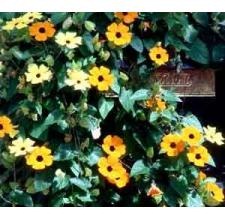Black-eyed Susan vines are related to the wildflower of the same name. They are easy to distinguish, not only because they grow taller, but because they have a different type of petal. The only drawback is that they cannot be grown in a large number of planting zones.
History
-
Black-eyed Susan vines make beautiful displays and can be grown from seeds or cuttings. In colder climates, where they are annuals, it is best to start then indoors early on or outdoors after the danger of frost. It is only in the very warmest climates where they can be considered perennials.
Geography
-
Black-eyed Susan vines are hearty only in zones 9A to 10B. They like mildly acidic to mildly alkaline soil, full sun or partial shade and not too much water. They bloom from late spring to early fall.
Features
-
Black-eyed Susan Vines will grow anywhere from 6 to 8 feet tall. They can share space in the garden with other plants that grow in the same conditions. They are not invasive plants and there are no warnings associated with them. You can collect the seeds from the flowers each fall–just let them dry on the vine first.
Identification
-
The vines are easy to spot as each flower has five petals surrounding the jet-black center. They come in a variety of colors–red, orange, red-orange or bright yellow, which is the most popular.
Benefits
-
Black-eyed Susan vines are very versatile. The can be grown over an arbor, along a fence, in containers or even as ground cover. They don’t need much water or fertilizer and have a wonderful fragrance.


Deprecated: strpos(): Passing null to parameter #1 ($haystack) of type string is deprecated in /home/agriviek8Qv/agriviet.net/public_html/wp-includes/comment-template.php on line 2522